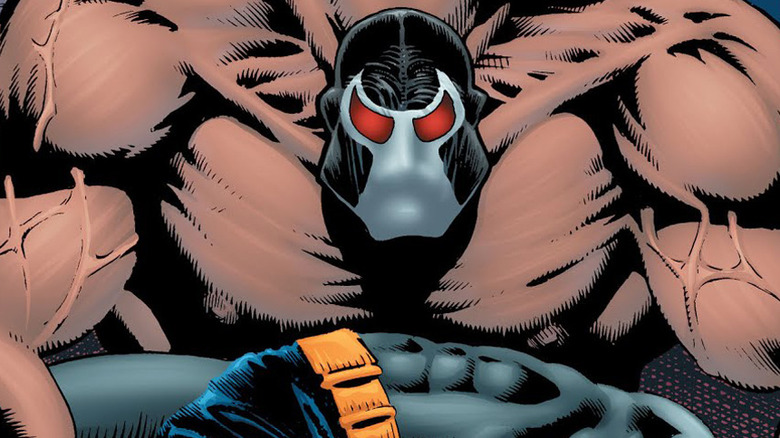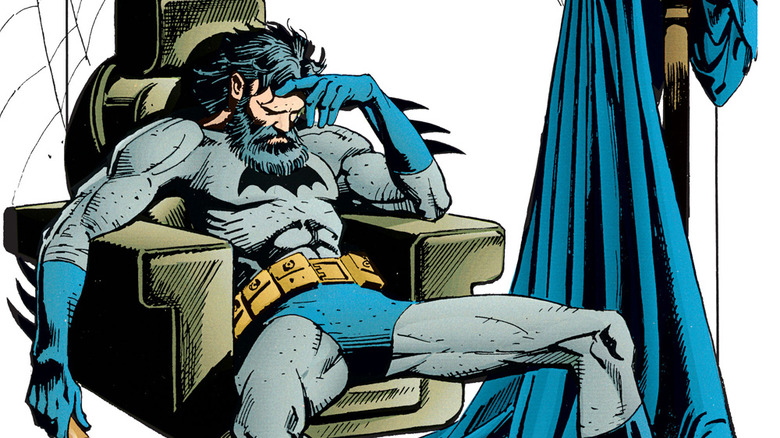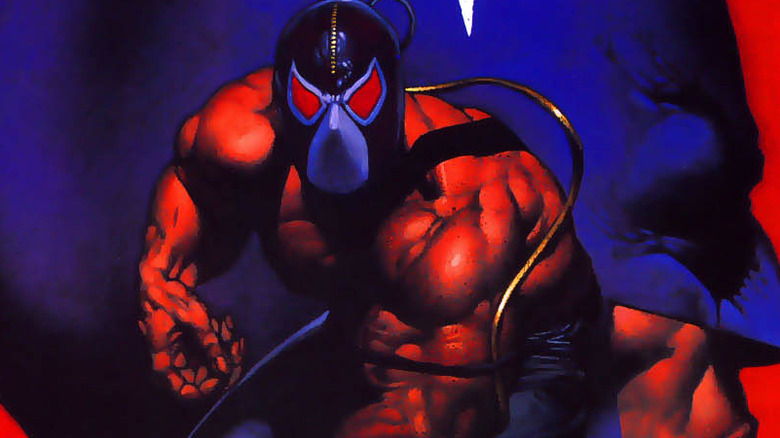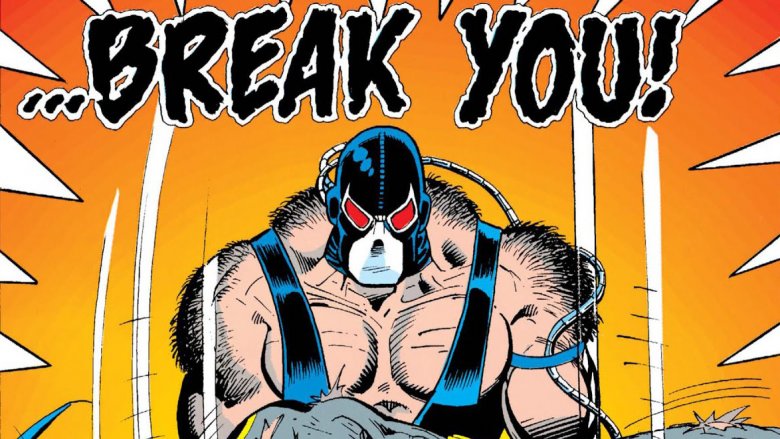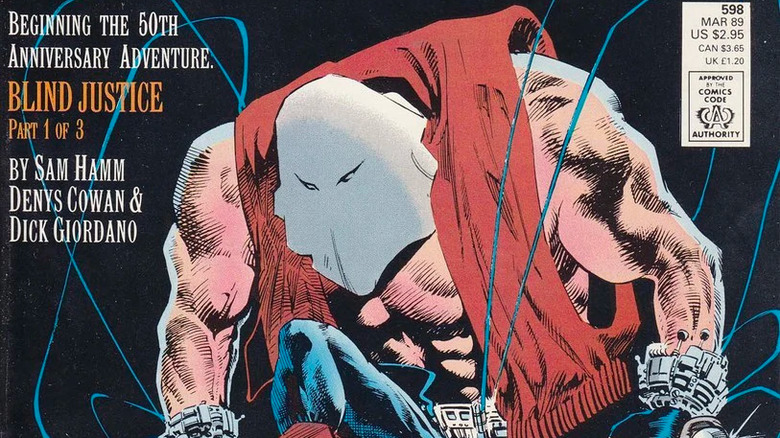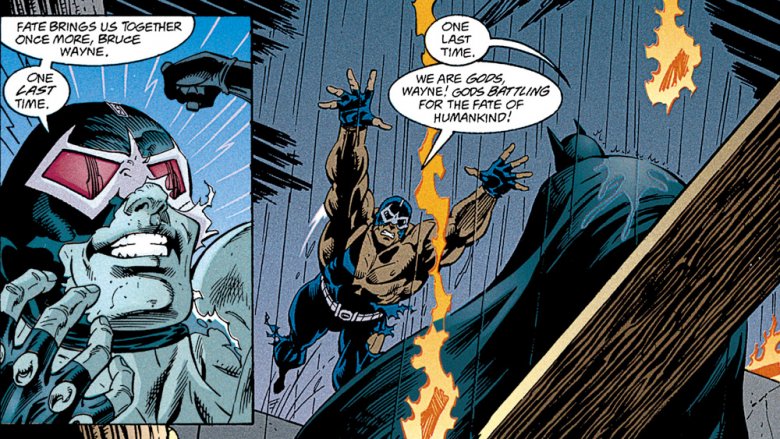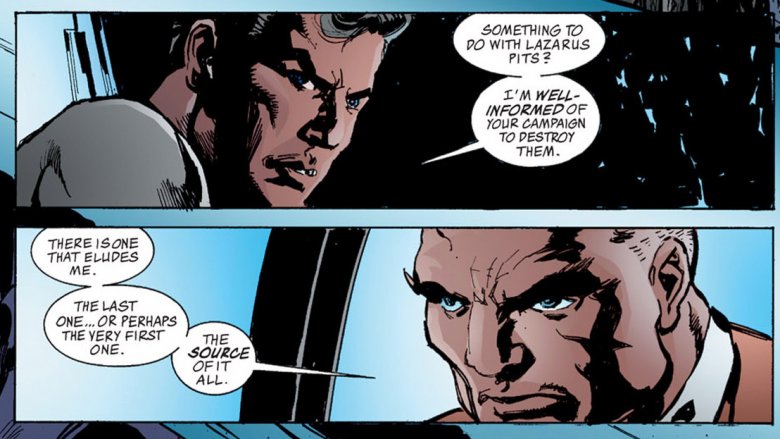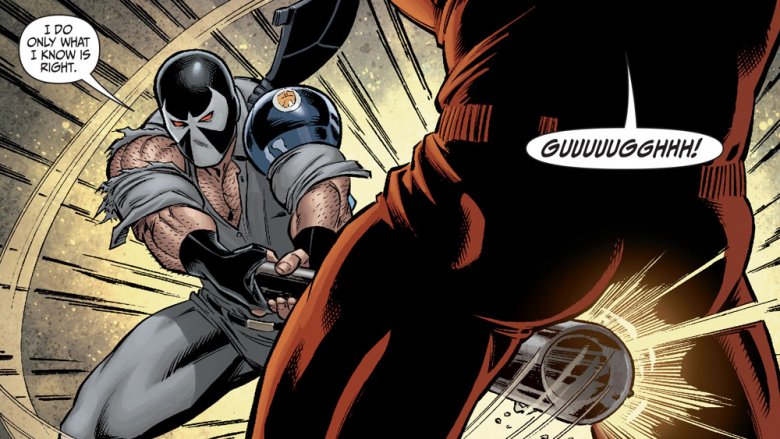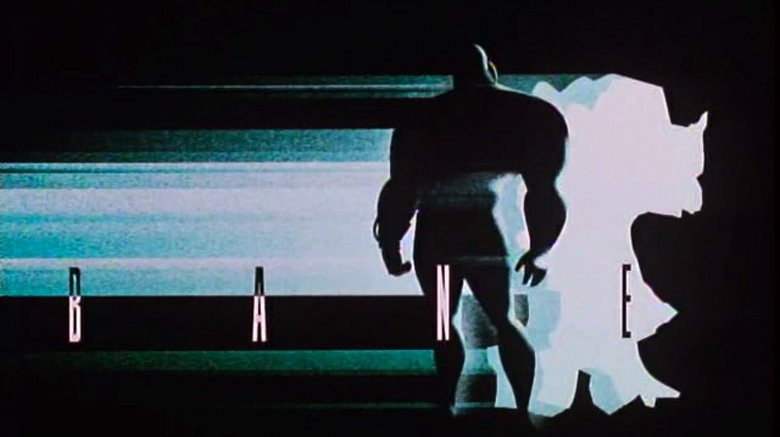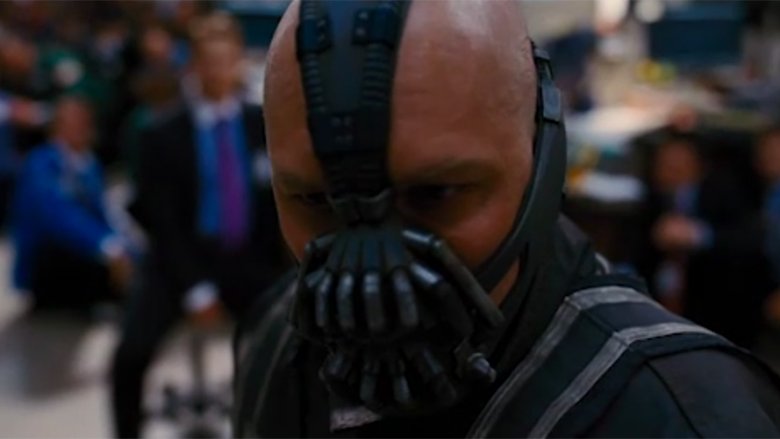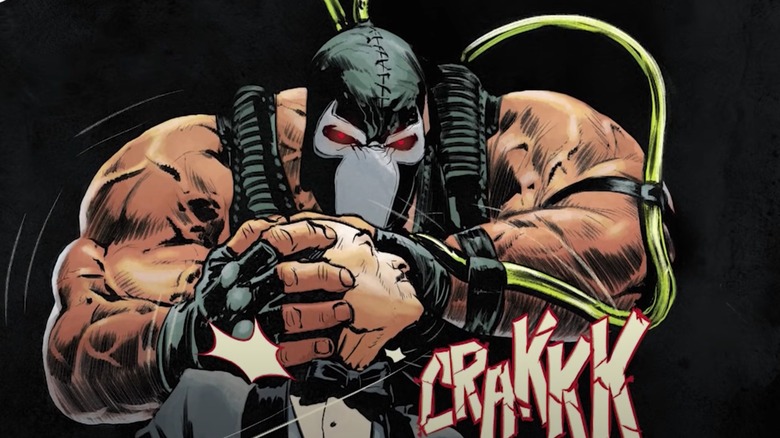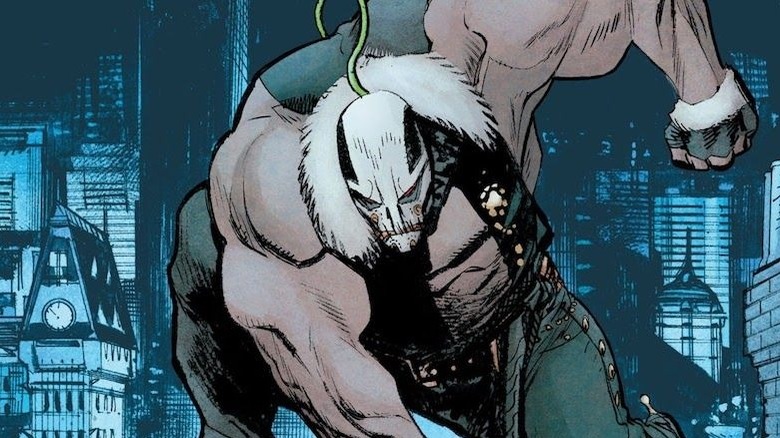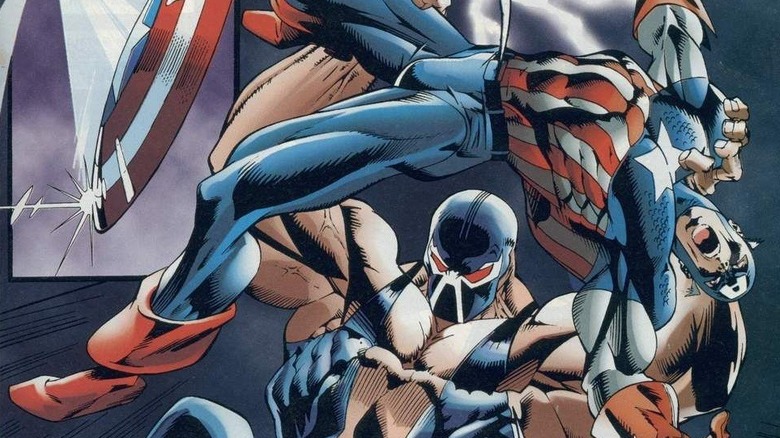The Untold Truth Of Bane
Of all the supervillains in Batman's considerable gallery of foes, there's only one who can claim to have truly beaten the Dark Knight: Bane. He was the mastermind of one of the most brutal Batman stories ever printed, which climaxed in the famous moment where he shattered Bruce Wayne's spine over his knee and ruled Gotham City's criminal underworld. That didn't last, of course, but over 20 years after his victory in "Knightfall," he's been able to maintain his mystique better than almost any other modern villain, for one simple reason. No matter how many times he might've been defeated since, he'll always be the man who broke the Batman.
There's more to Bane than just that single story, though. From a twisted origin to the unknown prototypes that paved the way for him, and all the way to his tenure as a kinda-sorta good guy, here's the truth behind Batman's overpowered nemesis.
Venom (no, the other one)
Before there was Bane, there was Venom — but not the guy who looks like a jacked mall-goth Spider-Man, the other one. This one was a super steroid that originally appeared in the pages of a 1991 "Legends of the Dark Knight" story of the same name by Denny O'Neil, Trevor von Eden, and Russell Braun.
In that story, Batman came up against the limitations of being a superhero who was "only human." While we're used to seeing him rack up victory after victory thanks to his physical training, boundless intellect, and massive personal fortune — and, you know, the kind of writing that comes from his name being on the cover of the comic — he wasn't strong enough to save a little girl who had been trapped behind a massive boulder. To solve that problem, he turned to a designer steroid called Venom, which allowed him to surpass those physical limitations, granting him superhuman strength.
Unfortunately, Venom wasn't without its drawbacks. It drove Batman into uncontrollable rages and was so addictive that its creators were almost able to blackmail him into killing Jim Gordon to get more pills. After realizing that the Venom had become a weakness rather than a strength, Batman beat his addiction by quitting cold turkey and locking himself in the Batcave for a month... but not before the drug's creators made it to the small South American nation of Santa Prisca to continue their research.
Vengeance of Bane
Two years after the introduction of Venom, 1993's "Vengeance of Bane" introduced the world to its most famous user. The super-steroid was only half of the equation, though, and the other half was one of the wildest origin stories ever committed to comics.
Bane — he's never been given any other name in comics — was given a life sentence in prison before he was even born. His father had been on the losing side of a revolution in Santa Prisca, and because of "the medieval codes of this island nation," his first-born son had to carry out his prison sentence in Peña Duro after he died. Bane's mother was imprisoned while she was pregnant, and raised him in prison until she died when he was six. After that, he was thrown into the prison's general population, and after being scouted for unsavory purposes by one of the other prisoners, he had a vision of himself in the future in a "perfect form." He killed the other prisoner the next day, and was put into a pit that would flood every night at high tide, where he spent the next ten years surviving out of spite by holding himself just above the water and eating whatever fish he could catch in his teeth — and also doing a whole lot of pushups.
He also developed his own set of meditation techniques to hone his mind, and when he was let out of solitary at 16, he quickly learned to read and studied every book he could. He also volunteered for an experiment on a super-steroid that would allow him to achieve that "perfect form" he'd had a vision of so many years earlier. After becoming the unquestioned master of the prison he'd been born into, a fellow criminal's tales of Gotham City inspired him to become the master of that place as well. He just had to take out the guy who was already controlling the place.
Knightfall
"Vengeance of Bane" had set its title character up as an interesting inversion of Batman. Like the Caped Crusader, Bane had a brilliant mind and had trained himself to physical perfection, and he'd also inherited something from his father. The difference was that Bane's inheritance, a life sentence in a torturous Santa Priscan prison, had forged him into a murderer.
While the "Knightfall" storyline that followed is mostly remembered for the brutal fight between Batman and Bane, it's worth noting that over the course of the story, Bane's intellect was just as important as his physicality. His plan to beat Batman was actually brilliant in its simplicity: before fighting Batman himself, he broke every single criminal in Arkham Asylum out at the same time. The result was that Batman spent 10 issues running a gauntlet of his deadliest foes — including the Joker, the Scarecrow, Killer Croc, the Mad Hatter, and more — before he ever came face-to-face with Bane.
What makes it work so well is that it turned Batman's greatest strength, his relentless dedication to fighting crime, against him. There was no way that Batman was going to let Gotham City's supervillain population run wild on the city, so it makes sense that he'd push himself to the limit trying to bring them all down one after the other. The exhausted Batman was easy prey for Bane, who snapped Batman over his knee in the pages of "Batman" #497 to make way for the all-new, all-different Batman, Jean-Paul Valley, to debut in "Batman" #500.
Blind Justice
If you're a fan of "Knightfall," you might want to check out "Blind Justice," a Batman story that ran in the pages of "Detective Comics" #598 to #600, by Sam Hamm and artist Denys Cowan. In that story, a hulking, muscle-bound villain named Boneshaker pushed Batman to the limit and shattered his bones, leaving him unable to fight crime and leading him to pass the mantle to a blonde substitute. If that sounds familiar — and if Boneshaker's design, with his pro-wrestling-esque mask and the wires connecting from a high-tech belt to his wrists, seems to ring a bell, too — then there's a reason for that. It has a lot of the same story beats as "Knightfall."
The only thing is, "Blind Justice" came out in 1989, four years before Bane made his first appearance. It's not like this was an obscure story, either: Hamm was the screenwriter of the wildly popular 1989 Batman movie, and the saga was printed across three oversized, 80-page issues that were touted as a celebration of Batman's 50th anniversary. That said, it was never as popular as "Knightfall," which eclipsed it as one of the most notable events in "Batman" history.
Beyond the suspiciously similar surface elements, the look of the villain, and the idea of a replacement Batman, the two stories have plenty of different elements, and Bane is a far more interesting and complicated character than the Boneshaker was. Still, looking back on them both, it's hard not to see "Blind Justice" as a prototype for what happened a few years later.
The Rematch
The first time Batman took on Bane, the Dark Knight was exhausted and already half-beaten, and Bane was juiced up on Venom with the strength of several men. Eventually, however, they'd have a rematch in the pages of "Detective Comics" #701, and things would be very different.
At the time, Bane had teamed up with Batman's immortal foe, Ra's al-Ghul, who was devastating Gotham by unleashing a plague on the city that threatened to spiral into a full-on genocide. Ra's had named Bane as his heir — a dubious honor previously held by Batman, who had refused to take over the League of Assassins several times by this point — and their supervillain team-up eventually led to Bane confronting Batman in the lab that held the last samples of the plague.
The brawl that followed was quite literally explosive — over the course of the fight, Batman blew up the lab, sending their rematch out onto the docks of Gotham's waterfront. As they usually do, things looked bad for Batman for a moment, but this time, the Dark Knight focused his anger into a crushing series of punches that left Bane defeated once and for all. Mostly.
Bane vs. Ra's
Bane's tenure as the heir to Ra's al-Ghul's international criminal empire didn't exactly end well, and when the villains inevitably turned on each other, Bane turned his obsessive hatred to Ra's instead of Batman. This time around, though, he didn't just settle for destroying him in a physical confrontation. He decided to end al-Ghul's immortal life once and for all.
Ra's, of course, uses the mystical Lazarus Pits to stay alive and keep his body safe from the ravages of age, which makes him uniquely difficult to kill. Bane can snap Ra's over his knee as much as he wants, but as long as the Lazarus Pits are around, Ra's can be revived, good as new. With that in mind, Bane put his inside knowledge as a former member of the League of Assassins to good use by tracking down and destroying every Lazarus Pit in the world. He even got Batman to help with what he thought was the final one.
It worked, too. Ra's was driven to desperation and eventually killed by his daughter, Nyssa. Needless to say, he eventually came back, but Bane proved to be surprisingly effective at taking him down. All told, Bane spent about as much on-panel time trying to take down Ra's as he did trying to take down Batman, even if it was a little less notable.
The Secret Six
Bane's introduction as a compelling and effective villain made him a fan favorite, and like so many fan-favorite villains before him, he eventually found his way into the role of a protagonist. This wasn't unprecedented — he'd been the star of several one-shots that were focused on his origin and his non-Batman-breaking exploits — but in 2008, he found a new home in the pages of "Secret Six."
The original Secret Six had been a short-lived team in the '60s that focused on six undercover agents who had been gathered by a mysterious figure named Mockingbird. Their book didn't last, but DC revived the title in 2006 as something that was more like the Suicide Squad: A team of villains operating as mercenaries who often found themselves fighting against people far worse than they were.
Bane joined the team in the first issue of their ongoing series as the new sixth member, replacing the new "Mockingbird" after he was revealed to be Lex Luthor. Despite beating his addiction to Venom, Bane was the muscle of the group and quickly developed an interesting relationship with one of his teammates, Scandal, the daughter of Vandal Savage. It was by no means a romance — during the time that series was being published, Scandal was one of DC's most high-profile lesbian characters — but there was a fatherly tenderness towards her that revealed an entirely new side of his character.
Bane: The Animated Series
Like most of Batman's more popular villains, Bane was featured on "Batman: The Animated Series." While villains like Mr. Freeze and the Mad Hatter were given a new depth in their appearances, though, Bane was the opposite.
Rather than masterminding his own plot to take over Gotham City, the "Animated Series" take on Bane — voiced by Henry Silva in his first appearance, an episode appropriately titled "Bane" — was pretty much just hired muscle brought in by Rupert Thorne. He was presented as slightly more meticulous than other characters, and gathered information by beating it out of Killer Croc, one of Batman's strongest foes. In the end, though, while he was a solid physical challenge for Batman, the Caped Crusader took him down without anything close to the trouble he had in the comics.
There was an interesting footnote to his animated appearances, though: in "Batman Beyond," it was revealed that in the future, Bane's dependence on Venom had left his body withered and weakened in his older days. That didn't stop other criminals from adapting Venom for their own use, though, in the form of "slappers" that transferred it through contact with the skin.
The Dark Knight Rises
Bane made his big-screen debut in "Batman & Robin," and it wasn't exactly what you'd call the best adaptation of the character. In that movie, he was reduced to being a henchman for Poison Ivy who never even got a word of dialogue, and he was mostly there so George Clooney and Chris O'Donnell weren't asked to throw punches at Uma Thurman in a movie for children.
14 years later, Bane returned to the big screen as the primary antagonist of the third film in Christopher Nolan's "Dark Knight" trilogy, "The Dark Knight Rises." Here, he was played by Tom Hardy, and he was definitely not free of dialogue. In fact, Hardy's over-the-top, theatrical "Bane Voice," issued from behind a bizarre apparatus that approximated Bane's comic book mask, prompted an endless number of impressions from moviegoers.
The story drew on elements from throughout Bane's history on the page, taking the broad strokes of his relationship to Ra's al-Ghul by tying him into the League of Shadows, and giving him a similar victory over Batman. While we didn't get to see Batman run a gauntlet of his most fearsome foes, Hardy's Bane did snap Batman's back over his knee, leaving him paralyzed for a brief time. Sadly, Nolan did not see fit to include John Cena as Jean-Paul Valley to take over the role in '90s cybernetic armor. It might not have been good, but you have to admit that would've been an unexpected climax to the film.
The Penny(worth) dropped
Bane isn't exactly on the Bat Family's Christmas card list. Not only did he try to put an end to Batman by breaking his back in "Knightfall," but he was also the architect of one of the biggest tragedies in Bruce Wayne's entire life. In fact, it's arguably an even more heartbreaking moment than when the Joker blew up Jason Todd in "Death in the Family." The event in question is when Bane snapped Alfred Pennyworth's neck in "Batman" #77 by Tom King, Mikel Janín, and Tony S. Daniel. And the worst part about it? He did it in front of Damian Wayne, traumatizing the headstrong Robin for ignoring the warning that something bad would happen if he tried to enter the City of Bane.
While no one in comics stays in the grave for too long, Alfred's death was still a brutal twist. It was all part of Bane's master plan, as he realized that breaking the Bat physically might not be enough. Instead, he concocted a dastardly scheme where he destroyed every aspect of both Bruce Wayne and Batman. From ruining his wedding to Selina Kyle to recruiting Flashpoint's Thomas Wayne and snapping Alfred's neck, Bane ensured that the Dark Knight's life was in tatters after he was done with him.
Azrael put an end to an Elseworlds Bane
The "Knightfall" saga remains a hugely important comic book event for legitimizing Bane as a rogue, but it also introduced Jean-Paul Valley, aka Azrael, who became a brutal Batman in Bruce Wayne's absence. It's only fitting then that Azrael is the one who puts Bane down in the Elseworlds tale "Batman: Curse of the White Knight" #5 by Sean Murphy and Matt Hollingsworth.
Set in the Murphyverse, a non-canon DC universe, the tale shows Azrael taking Batman to his limits as he seeks revenge against Bruce Wayne and Gotham's criminals for a presumed injustice against his family. When Bane is sent to stop Azrael, the Order of St. Dumas' favorite son shows no mercy and slices Bane's head clean off his shoulders. He's not the only villain who falls to Azrael's flaming sword either, as the likes of Penguin, Riddler, and Two-Face all end up massacred as well. While Batman has always proclaimed to strike fear into the hearts of criminals, Azrael took things much further and made the rogues truly worried for their lives.
Bane nearly broke Captain America
The 1990s were a truly magical time for pop culture. The Tamagotchi arrived, driving parents and teachers up the wall, and Marvel and DC finally collided in a cross-company battle to determine which of their characters would come out on top in different dream match-ups. Headlining encounters like Batman versus Captain America and Superman versus Hulk dominated most of the pages of the "DC Versus Marvel" crossover series, but there was also a tense showdown between Cap and Bane.
As you might expect, Bane wanted nothing more than to break Captain America's back, since that's apparently his equivalent of the Stone Cold Stunner. Cap warns the villain not to mess with him, but Bane engages in the skirmish anyway. He flings his mighty shield, and Bane appears to dodge it, setting up Cap for his vertebrae crusher with a gorilla press slam and some mandatory trash talk. Then, in the nick of time, the shield returns and knocks Bane out cold, giving Cap the victory over the Santa Prisca bruiser. Imagine if Batman had brought his own boomerang shield when he faced Bane in "Knightfall" — it would have been a squash match.
